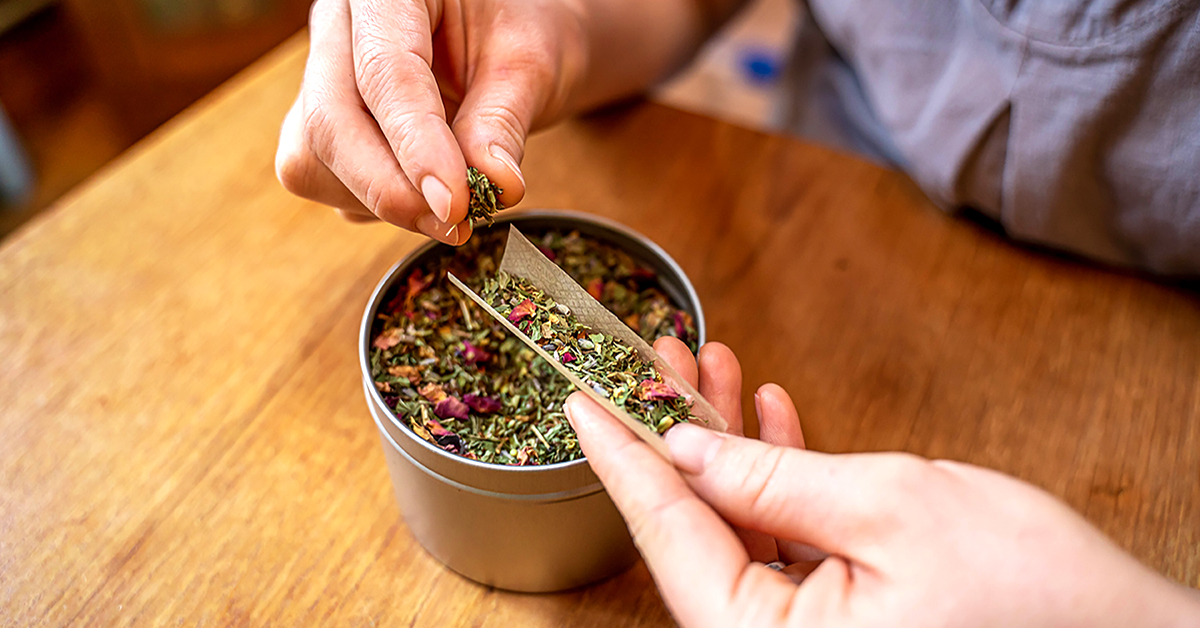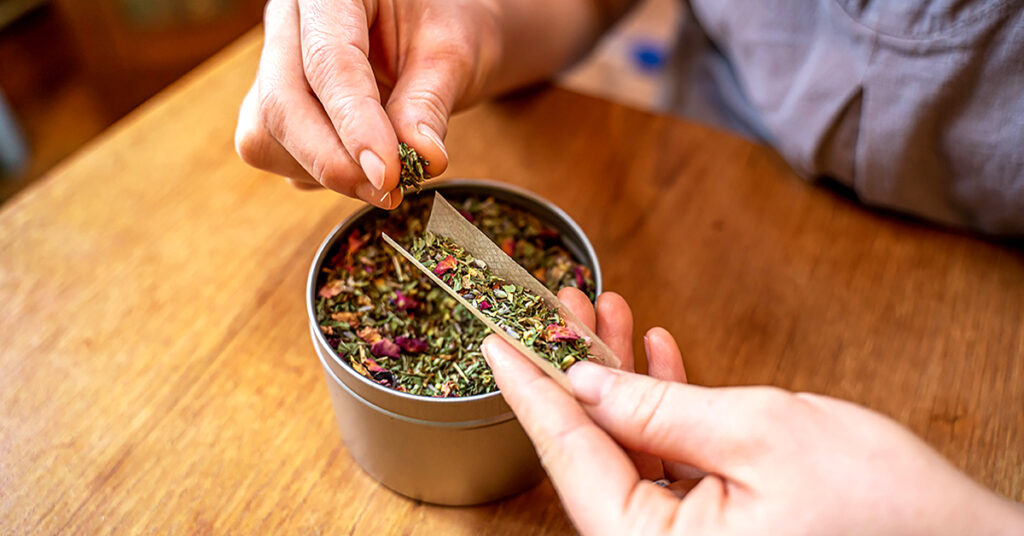
You might never have thought that smoking can actually have positive effects on your health, but this may be the case, depending on what you’re smoking. Now, don’t get me wrong – I’m not saying smoking is great for your health. But many herbs have been traditionally smoked over the centuries that can have health benefits. Smoking medicinal plants has also been commonly practiced to help people quit smoking Tobacco. In this blog post, you’ll learn the history of smoking herbs, a few of the most commonly smoked herbs, and their potential health benefits.
The Many Uses of Herbal Smoking
There are many reasons people smoke herbs: for ceremony, ritual, spiritual practices, recreation, and healing and therapeutic purposes. Some people simply enjoy the act of smoking and want to smoke something subdued, non-addictive or habit-forming. Smoking certain herbs can also help reduce the urges of Tobacco or Cannabis use by incorporating them into mixtures, and possibly slowly transitioning to only smoking non-addictive herbs.
The History of Smoking Plants
It’s believed that smoking plants have been present in every human society in history [7]. In the Bronze Age, about 5,000 years ago, the inhalation of burned plants was used in magic, ritual, and medicine in India, Mesopotamia, and Egypt. Some archaeologists believe that Stone Age shamans inhaled psychotropic plants to connect with the gods [7]. Smoking certain herbs truly transcends the boundaries of time and space.
Native American History of Herbal Smoking
Tobacco use is considered medicinal and ceremonial to shamans, healers, and medicine people across many cultures and worldviews [1]. A recent study by the University of Chicago revealed that traces of Tobacco were found in Native American ceremonial pipes dated before and after European colonization of North America [4]. They found the Tobacco species N. quadrivalvis (now extremely rare) and Sumac (R. glabra) in one of the pipes dated before European colonization. Sumac was often mixed with Tobacco for its medicinal qualities and to improve the taste of the smoke [4].
North American Indigenous communities traditionally smoke around 100 different plant species [4], including Corn Silk, Lobelia, Yerba Santa, and many Artemesia species like Wormwood and Mugwort [9]. One of the most notorious herbs smoked by Native Americans is called Kinnikinnick, which is an Unami word that also means “smoking mixture.” But the word Kinnikinnik also refers to the plant Bearberry (Uva Ursi), and both the leaves and red bark of this plant are traditionally smoked by many Native groups. Usually, the “Kinnikinnik” mixture contains plants like Willow bark, Manzanita, Madrone leaf, and many more [6].
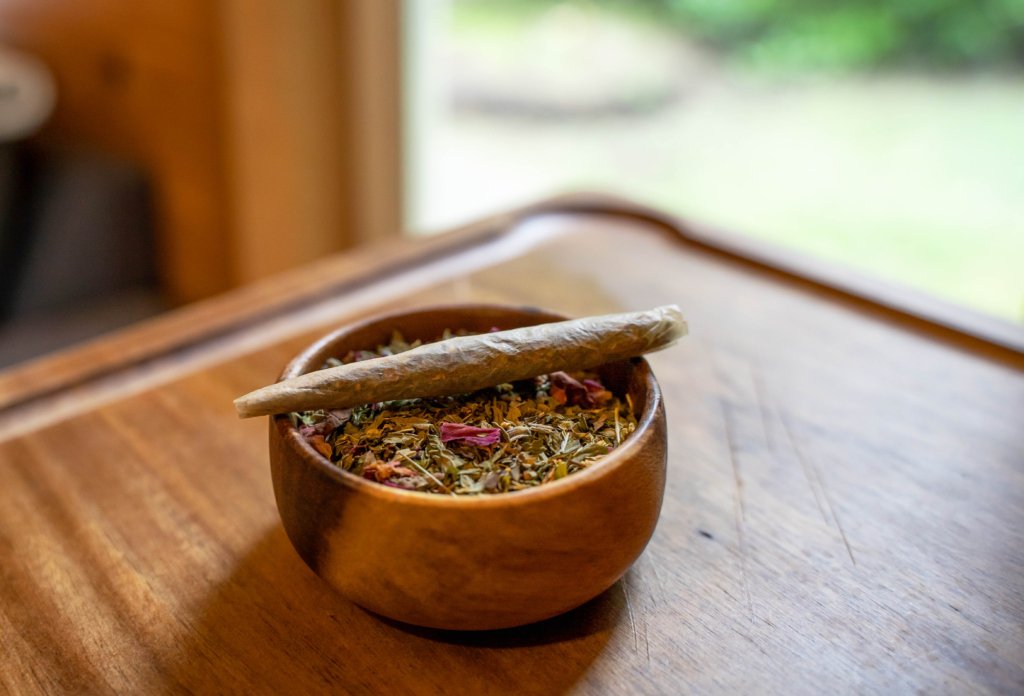
European History of Herbal Smoking
Prehistoric pipes found in excavations near Lumberg in the Netherlands were once considered to be smoking tools of giants, fairies, elves, and earth spirits, but now it is understood that they were used in Pagan’s ceremonial smoke offerings [1].
In the nineteenth century, many illustrations of Santa Claus included him holding a pipe. He was often called “Baccy Claus”, the term baccy meaning “strong tobacco”[1].
Around Christmastime, many herbs were added to “baccy blends” to give aroma to the smoke, including Anise, Benzoin, Cassia Flower, Cardamom, Cinnamon, Cloves, Coriander, Gum Mastic, Iris Roots, Lemon Rind, Rose Blossoms, Star Anise, Storax, and Valerian [1].
Many other medicinal herbs, including aromatic plants, were mixed into everyday baccy blends, including Arnica, Blackberry, Burdock, Belladonna, Coltsfoot, Elder, Hawthorn, Linden, Mugwort, Mullein, Lavender, Roman Chamomile, Rose, Sage, Wild Rosemary, and Yarrow [1]. A basic baccy recipe included equal parts Coltsfoot, Veronica, and Blackberry, which would sometimes be smoked alone, or mixed with Tobacco and/or Hemp [1]. Modern European baccy products are marketed as “herbal mixtures to purify the air in the room” – which suggests that smoking herbs can be considered a type of incense burning [1].
Indian History of Herbal Smoking
In India, the practice of Dhumapana, or herbal smoke therapy, is used as a preventative and curative measure in Ayurvedic medicine. Dhumapana is the inhalation of smoke from non-addictive substances using a Dhumnetra (pipe-like instrument) [2]. Dhumapana is commonly used to treat respiratory tract diseases and other ailments related to the eyes, nose, and throat [2]. It’s also been suggested that Dhumapana could possibly be an effective treatment for COVID-19-like viruses, although more studies need to be conducted [3].
Some of the therapeutic herbs commonly used in Dhumapana include Cardamon, Clove, Nagakesam, Black Pepper, Ginger, Gugglu, Brihati, Kanta Karika, Karamarda, Asafoetida, Ingudi Bark, Guduchi, Manashila, Neem, Holy Basil, and Turmeric. Ghee is often used as a base material [3].
During the procedure, the patient is directed to sit with a calm mind and inhale the smoke through one nostril while the other is closed, using three puffs, then exhale through the mouth. The same process is repeated through the other nostril. Sometimes the smoke is inhaled through the mouth, depending on the condition being treated [2].
Dhumapana is a very particular and in-depth aromatic medicine technique where highly trained professionals who have studied the art for years will match particular herbs to an individual based on their unique constitution and conditions. Not all herbs used in Dhumapana will affect everyone in the same way. There are also many guidelines for the timings of treatment and contraindications to take into account. Therefore, it should only be conducted by authorized Ayurvedic practitioners.
Unlock Your Free Issue Of...
🌿 The Aromatic Medicine Garden Membership 🌿
Are you ready for a deeper, holistic dive into the world of aromatic plants? See what our membership is all about with your free sneak peek issue, including an hour-long plant talk and a 21-page plant monograph pdf.

5 Traditionally Smoked Herbs & Their Health Benefits
Smoking herbs can have potential health benefits because the act of smoking concentrates and delivers herbal compounds to the body with direct contact to the lining of the lungs, a sensitive mucous membrane [1]. From here, the active ingredients of the herbs can be absorbed into the bloodstream.
These 5 traditional herbs are commonly smoked either alone or added to smoking blends. They are all legal, non-addictive, and non-hallucinogenic. While they won’t get you high, they can produce a subtle euphoric feeling with some positive health effects.
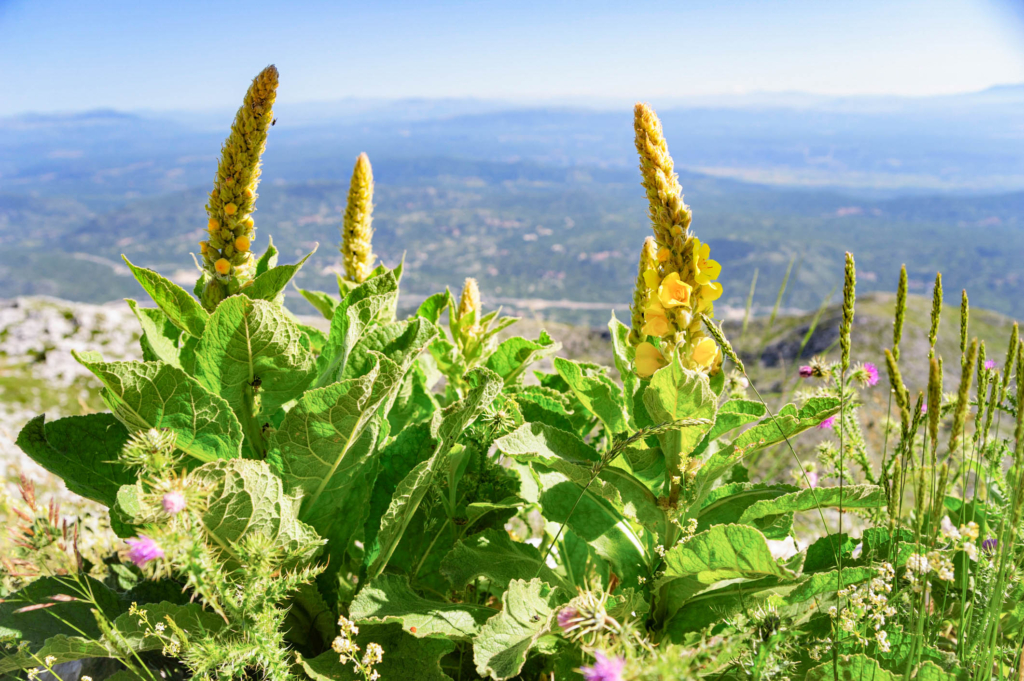
Mullein (Verbascum thapsus)
Mullein is one of the most commonly smoked herbal plants. Mullein is famous for its beneficial effects on the respiratory system and the plant's smoke is traditionally inhaled to relieve asthma and spasmodic coughing. A common practice for easing earaches includes gently blowing Mullein smoke into the ear canal [5].
Mullein’s light, fluffy leaves have a smooth, mild flavor when smoked, and can be smoked alone or in a blend. Mullein is believed to be opening to the lungs, so be mindful of this when mixing with other plants, especially Tobacco or Marijuana, as it may intensify the absorption and could be harmful.
Coltsfoot (Tussilago farfara)
Coltsfoot is known as an expectorant and can help clear the lungs, especially at the end of a respiratory cold or flu or when quitting smoking Tobacco [6]. Coltsfoot has been traditionally used to treat a persistent cough in conditions like bronchitis and seems to have a cooling and calming effect on the lungs when smoked [8].
Colsfoot’s leaves have a mild, neutral flavor, similar to Mullein. However, inhaling too much Coltsfoot smoke can cause coughing, so it’s best to include small amounts of this herb in blends [6].
Mugwort (Artemesia spp.)
Mugwort is most notoriously smoked for its effect on dreams. When the smoke of Mugwort is inhaled, especially before bedtime, it can promote vivid and lucid dreams. It has also been said to help reveal and even alter areas of psychic unconsciousness [5]. Mugwort’s aromatic leaves have a strong, pungent flavor when smoked.
Lobelia (Lobelia inflata)
Inhaling Lobelia smoke can be calming and relaxing. It is considered an expectorant, like Coltsfoot, meaning it can help clear congestion and open the lungs [6]. Lobelia is commonly smoked as a substitute for Tobacco because it contains an alkaloid called lobeline that your body easily mistakes for nicotine. Therefore, when Lobelia smoke is inhaled, receptors in your body think that it’s nicotine and that you just smoked Tobacco [6]. Lobeline is not addictive like nicotine when used properly and acutely. Chewing gums used to quit smoking include lobeline as one of the main ingredients [6].
Caution:
Lobelia is a very strong plant and is considered a low-dose herb. Consuming too much will induce vomiting. It is also a very strong muscle relaxant and tranquilizer that should not be mixed with any pharmaceutical medication or alcohol [6]. Do not consume without the guidance of a professional herbalist or other medicine practitioner.
Kinnikinnick (Arctostaphylos uva-ursi)
Both the leaf and red bark of Kinnikinnick have been traditionally smoked for ages by many Native groups, including the Blackfoot, Cheyenne, Chippewa, Keresan, Kwakiuti, Montana, Navaho, Ojibwa, Pawnee, and Thompson Indians [9]. Many Native people smoke the leaves for ceremonial and spiritual reasons. It is also commonly smoked for its calming effects and to help relieve headaches [9].
Kinnikinnick has a warm, hearty flavor when smoked. It is thought to be too harsh to smoke alone and is best included in blends. It adds a Tobacco-like “body” to the mix [6]. Smoking herbs with a body similar to Tobacco, like Kinnikinnick, can be helpful for folks trying to replace smoking Tobacco with herbs.
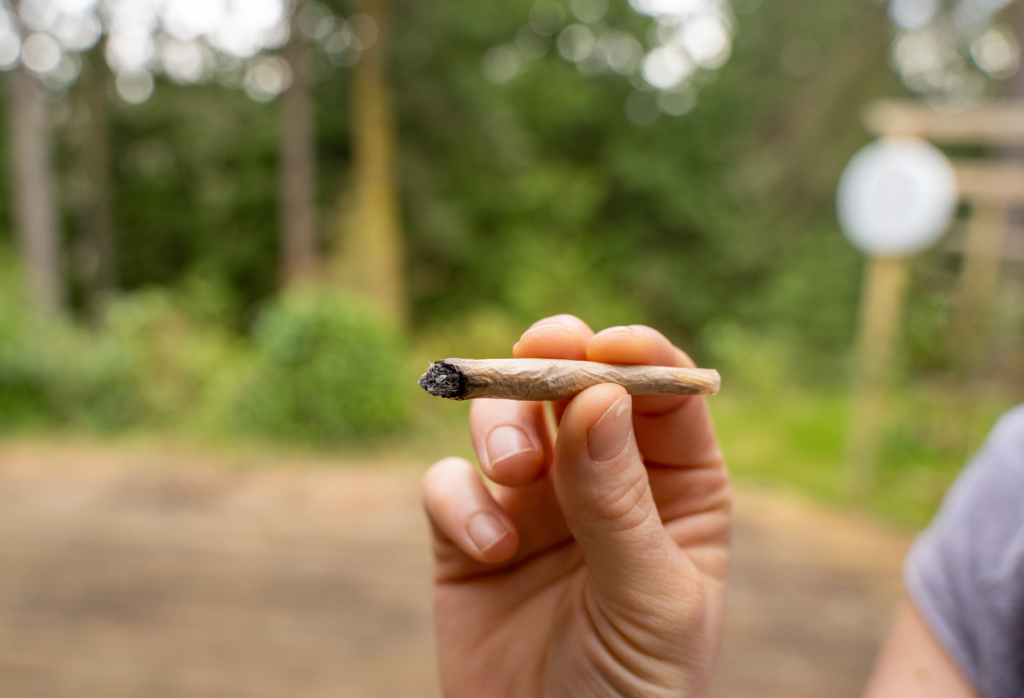
People have been smoking herbs for thousands of years across nearly every culture for a wide variety of purposes, from ceremonial to quitting smoking. We covered 5 of those plants and their potential health benefits in this post, but there are many more traditionally smoked herbs out there. That being said, if you’re feeling drawn to try smoking herbs, keep your body’s unique constitution in mind. Not all herbs affect everybody in the same way.
Disclaimer
The information provided is for educational purposes only. Smoking herbs is a dynamic practice and attempting it without the proper guidance of a professional can be harmful. Many herbs are unsafe to smoke. If you plan to try smoking plants, always use caution, and keep in mind that even some smoking herbs with historical therapeutic documentation may be harmful according to current safety standards. Please make informed decisions based on research and professional guidance about which herbs to include in your herbal smoking blends.
While some commonly smoked herbs have health benefits, smoking is not considered a healthy practice long-term. If you are looking for a more sustainable long-term approach to herbal wellness, plant extracts, teas, and other herbal preparations could be more appropriate since they don’t carry the health risks that are associated with smoking. If you have any respiratory health concerns, most definitely consult your doctor, herbalist, or natural healer about smoking herbs before you do so.
Article Written By Melissa Szaro

References
1. Rätsch, E, & Müller-Ebeling, C. (2003). Pagan Christmas. Inner Traditions.
2. Kumari, A. et al. (2019). Role of Dhumpana in nasal pathologies. International Ayurvedic Medical Journal. Retrieved from: http://www.iamj.in/posts/images/upload/2401_2406.pdf
3. Kumaravel, G. (2020). Dhumapana: An effective Ayurvedic treatment procedure for prevention, first aid and treatment of COVID-19 like diseases. Retrieved from: https://www.researchgate.net/publication/343111210_Dhumapana
4. Waxman, E. (2020). Study looks at smoking in pre-colonization North America. University of Chicago Medicine. Retrieved from: www.uchicagomedicine.org/forefront/biological-sciences-articles/study-on-ancient-smoking
5. Kloos, S. (2017). Pacific Northwest medicinal plants: Identify, harvest, and use 120 wild herbs for health and wellness. Portland, OR: Timber Press.
6. Brounstein, H. (1995). Herbal Smoking Mixtures. Retrieved from: http://botanicalstudies.net/herbalism/smoking-mixtures/
7. Jenner, G. (2015). Did People Smoke Anything Before Tobacco Was Discovered? History Extra. Retrieved from: www.historyextra.com/period/stuart/did-people-smoke-anything-before-tobacco-was-discovered/
8. Viereck, E. (1987). Alaska’s wilderness medicine: healthful plants of the far north. Portland, OR: Alaska Northwest Books. Retrieved from: http://www.ankn.uaf.edu/curriculum/books/Viereck/index.html
9. Richter, C. (1998). Native American Smoking Herbs. Retrieved from: https://www.richters.com/show.cgi?page=QandA/Aromatic/19980727-1.html
© 2021 The Northwest School of Aromatic Medicine. All rights reserved.
*The statements above have not been evaluated by the FDA, and are for educational purposes only. This article is not intended to diagnose, treat, cure, or prevent any disease. This article should not be taken as medical advice. Please consult your physician before you use this information for health purposes.
